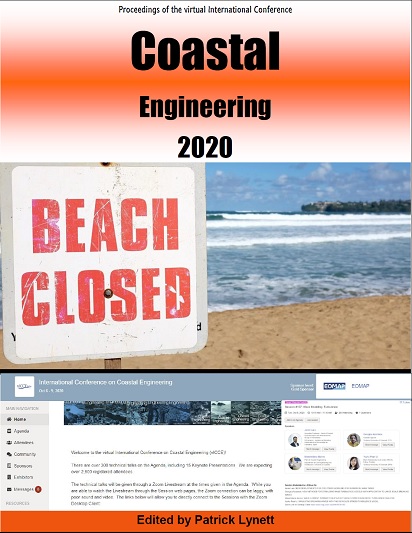Abstract
In this work, a data assimilation approach treating bathymetry as an uncertain model parameter, is introduced where direct dissipation estimates from remote sensing data are the unique data source. Two dimensional wave breaking dissipation fields are retrieved on a wave-by-wave basis with the algorithms of Daz et al. (2018), who were able to reliably estimate breaking dissipation by removing spurious signals affecting electro-optical and microwave data. After a six hour application, the system was able to retrieve improved bathymetric estimates, without any in situ depth measurement. A prominent feature of this approach is its ability to reliably capture the amplitude and position of nearshore sandbars.Recorded Presentation from the vICCE (YouTube Link): https://youtu.be/Y7mgiSvmRYc
References
Aarninkhof, Ruessink, Roelvink (2005). Nearshore subtidal bathymetry from time-exposure video images. Journal of Geophysical Research, 110, 2005
Battjes, Janssen (1978). Energy loss and set-up due to breaking random waves. Proceedings of the 16th International Conference on Coastal Engineering
Booij, Ris, Holthuijsen (1999). A third-generation wave model for coastal regions, Part I, Model description and validation. J. Geophys. Res.. 104.7649-7656.
Brodie, Palmsten, Hesser, Dickhudt, Raubenheimer, Ladner, Elgar (2018). Evaluation of video-based linear depth inversion performance and applications using altimeters and hydrographic surveys in a wide range of environmental conditions. Coastal Engineering. 136.
Catalán, Haller, Holman, Plant (2011). Optical and Microwave Detection of Wave Breaking in the Surf Zone. Geoscience and Remote Sensing, IEEE Transactions on. 49. 1879 - 1893.
Catalán, Haller (2008). Remote sensing of breaking wave phase speeds with app lication to nonlinear depth inversion. Coastal Engineering. 55. 93- 111.
Dally, Brown (1995). A modeling investigation of the breaking wave roller with application to cross- shore currents. Journal of Geophysical Research. 1002. 24873-24884.
Díaz, Catalán, Wilson (2018). Quantification of Two- Dimensional Wave Breaking Dissipation in the Surf Zone from Remote Sensing Data. Remote Sensing. 10. 38. 10.3390/rs10010038.
Duncan (1981). An experimental investigation of breaking waves produced by a towed hydrofoil. Proc. R. Soc. Lond. A, 377, 331–348.
Haller, Honegger, Catalán (2014). Rip Current Observations via Marine Radar. Journal of Waterway Port Coastal and Ocean Engineering. 140. 115-124.
Holman, Haller (2013). Remote Sensing of the Nearshore. Annual review of marine science. 5.
Holman, Plant, Holland (2013). CBathy: A robust algorithm for estimating nearshore bathymetry. Journal of Geophysical Research: Oceans. 118.
Holman, Stanley (2007). The history and technical capabilities of Argus. Coastal Engineering. 54. 477-491.
Long (1996). Index and bulk parameters for frequency- directional spectra measured at CERC Field Research Facility, July 1994 to August 1995, Misc. Pap. CERC-96-6, U.S. Army Eng. Waterw. Exp. Stn., Vicksburg, Miss.
Reniers, Roelvink, Thornton (2004). Morphodynamic modeling of an embayed beach under wave group forcing. Journal of Geophysical Research.
van Dongeren , Plant , Cohen , Roelvink , Haller , Catalán (2008). Beach Wizard: Nearshore bathymetry estimation through assimilation of model computations and remote observations. Coastal Engineering. 55. 1016-1027.
Wilson, Özkan‐Haller, Holman, Haller, Honegger, Chickadel (2014). Surf Zone Bathymetry and Circulation Predictions via Data Assimilation of Remote Sensing Observations. Journal of Geophysical Research: Oceans. 119.
Wilson, Berezhnoy (2018). Surfzone State Estimation, with Applications to Quadcopter-Based Remote Sensing Data. Journal of Atmospheric and Oceanic Technology. 35.

